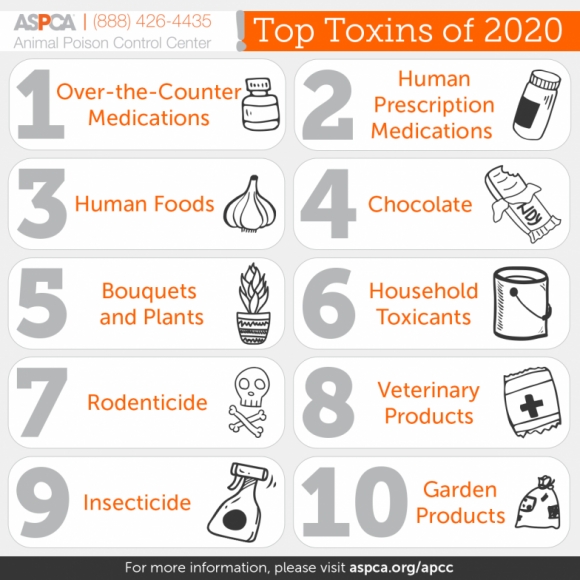


ASK US
Top Pet Toxins of 2020
Each year the ASPCA Animal Poison Control Center (APCC) compiles its data from the calls they receive about pets exposed to toxins and releases the Top 10 categories of potential poisons.
In 2020, the APCC helped over 370,500 animals, resulting in a 13% increase in case volume, with cases from all 50 states and countries across the world.
While over-the-counter and prescription medications remained serious concerns, there were some surprises in response to the drastic changes in people’s lives last year. As new hobbies such as baking and gardening saw a rise in popularity, many pets had more access to potentially toxic items such as chocolate, yeast dough, and indoor and outdoor plants. There was an 11% increase in case volume in chocolate exposure, a 51% increase in yeast dough exposure, and a 40% increase for indoor and outdoor plant incodences.
The APCC grouped the hundreds of thousands of exposures they assisted with into the following categories, starting with the most frequent. 
1. For the third year in a row, human over-the-counter (OTC) medications lead the top toxins list, making up nearly 17% of APCC's total case volume. The most common items in this category include cold medications, vitamins, and pain relievers such as ibuprofen, naproxen, and acetaminophen, which can all cause life-threatening medical issues. Because these items are easily accessible to pets in homes, purses, and backpacks, the ASPCA urges pet owners to take extra precautions and keep all toxic items, especially medications, securely locked in a cabinet.
The remaining nine items on the 2020 list, making up nearly 80% of all APCC cases, include the following:
2. Human Prescription Medications remained at number two in 2020 with antidepressant, anticonvulsant, and cardiac medication ingestions being the most common cases. Like OTC medications, many of these prescriptions can cause gastrointestinal issues and may even lead to kidney failure.
3. Food Products continue to occupy the third spot, making up 13% of total cases in 2020. This year, protein and snack bar exposures along with grapes, raisins, xylitol, onions, and garlic made up most food toxicity cases.
4. Chocolate ingestion cases continue to increase year after year. APCC handles almost 76 cases of chocolate exposure EACH DAY! It's important for pet owners to remember that the higher the cocoa content, the more dangerous the chocolate will be for your pet.
5. Plants, both indoor and outdoor, moved up three spots to number five in 2020, with the APCC seeing 9,000 more plant-related calls compared to the previous year. At the start of the pandemic, more people found themselves decorating with plants, especially succulents, or sending bouquets to friends and family. While many plants pose a serious threat to pets, there are also many pet friendly houseplants consider.
6. The last five toxins on the list include household items such as cleaning products and paint; rodenticides; veterinary products such as pet medications; insecticides and gardening products including fertilizer.
If you think your pet may have ingested a potentially poisonous substance, call (888) 426-4435 or contact your local veterinarian as soon as possible.



